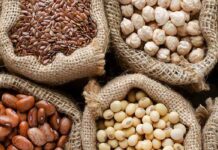Chai Tea: Steeped in History
In recent years, we have seen an increase in the popularity of chai, but not many people are aware of the wide variety of different Indian chai teas that exist, as well as the many health benefits of drinking chai. The trending tea has a rich history – and much more behind its value than being an enjoyable beverage.
History of Chai
In America, the term “chai” has come to refer to a particular tea beverage with Indian spices, although the original “chai” recipe did not include tea leaves. According to legend, the beverage that would eventually become chai tea originated long ago as a “healing spiced beverage” ordered by a king for use in the healing practice of Ayurveda. Ingredients in chai varied by region in India and were selected for the healing properties each spice was believed to possess. These included ginger and black pepper (digestion), cloves (pain relief), cardamom (mood) cinnamon (respiratory and circulation, and star anise (fresh breath).
It was not until the middle of the 1800s that the now classic components of tea leaves, milk and sugar became a standard part of the chai tea recipe. This corresponded with the British discovery of the Camellia sinensis tea leaves in India, and their favoring of dark tea with the added sweetness of milk and sugar.
Production and Farming of Tea
The tea industry in India was initially spurred on by the British, but quickly grew to be a widely consumed beverage. India is now the second-largest producer of tea in the world. Much of the variety in chai tea can be connected to geographic locations, and the balance of flavor depends greatly on local taste. While cardamom, ginger, cloves, cinnamon and black peppercorns are traditional to most varieties, other include nutmeg, mace and fennel. Tea’s journey west added bay leaf allspice, cacao and saffron to the mixture.
India is one of the pioneers of organic tea farming, which uses environmentally-safe techniques and avoids using synthetic fertilizers and pesticides. This started in 1986, primarily in the Assam region, due in large part to the Singpho people, but has grown and spread due to increasing global demand for organic tea in recent years. Much of the organic tea production takes place on large tea estates; where the signature fragrance of the plants can be experienced. Particularly with the rise of organic tea farming, tea tourism is rapidly becoming an important aspect of India’s economic, following the leads of China, Sri Lanka and Kenya.
Medicinal Benefits of Chai
The spices in chai tea are very medicinally active and have a wide variety of health benefits. For example, ginger, cloves and cinnamon are all anti-inflammatory, which means they can relieve gum pain and inflammation of the joints. Black tea and ginger, meanwhile, are powerful antioxidants that have been linked to decreasing the possibility of a cancer diagnosis.
Chai is also often consumed after a meal because of its ability to assist with digestion. Black pepper, for instance, supports the pancreas, which release digestive enzymes, while ginger is commonly used to help relieve nausea and aid in healthy digestion.
Many of the herbs can also help with weight loss and be used to maintain a good level of blood sugar. Cardamom is filled with fiber, which helps you feel full and stabilizes your blood sugar. Fennel has been linked to reducing water retention because it is a natural diuretic. Tea is also a generally healthier alternative to other beverages such as coffee or soda, and the simple replacement can be helpful in maintaining a healthy lifestyle.
10 Tea Producing Countries in the World
10. Argentina – Tea is a significant part of the Argentinian culture. Owing to the large variations in climate and geology, Argentina manages to produce around 69,924 tonnes of tea, with Black tea being in highest production. Mate, a traditional herbal brew, made from the leaves of yerba mate plant, is very popular in Argentina – and is, in fact, their national drink.
9. Iran – Iran became a large producer of tea in the 19th century. Today, nearly 32,000 hectares of tea farms produce about 83,990 tonnes of tea in the country.
8. Japan – The country produces about 85,900 tonnes of tea annually, out of which only 2% is exported. Green tea is the most common tea in Japan, with variants which include bancha, sencha, genmaicha and hojicha.
7. Vietnam – A unique industry that has both large-scale and small-scale producers of tea, Vietnam is known for diverse varieties like black, green, lotus and jasmine teas, totalling to about 116,780 tonnes in annual production.
6. Indonesia – Known for its black tea production, Indonesia exports almost 65% of the 157,388 tonnes of tea it produces.
5. Turkey – Turkish, or Rize Tea, is the most famous Black Tea produced in the country. Turkey produces about 174,932 tonnes of tea annually, owing to its favourable topography, wet climate and proximity to the Black Sea.
4. Sri Lanka – Tea production is one of the largest industries in Sri Lanka, employing over 1 million workers. The country produces about 295,830 tonnes of tea annually, out of which the Ceylon Black, Ceylon Green and Ceylon White teas are the most famous.
3. Kenya – Nearly 90% of the tea grown in Kenya is produced in small farms. Kenya produces about 303,308 tonnes of tea annually and the country has become a leader in producing new varieties that tend to grow abundantly.
2. India – A country with over 1 billion tea drinkers, India’s annual tea production is about 900,094 tonnes. The exclusive Assam and Darjeeling varieties have gained recognition all over the world.
1. China – Undeniably the largest tea producer in the world, China produces about 1,000,130 tonnes of tea; that contributes to nearly 30-35% of the world’s tea production. Tea is at the centre of various cultural rituals in China, making it an important beverage for the Chinese.










